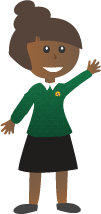
History


Intent
The heart of our intent rests with the children of St James. We have ensured that the History curriculum reflects our school community, the local area as well as the national curriculum. Our History curriculum is a celebration of diversity meaning children are able to see themselves in the History we teach. This will empower them to find their own voice through this understanding that the past and their heritage and how this History has shaped many different people. Our curriculum sparks curiosity and enthusiasm in our pupils and allows them to discover a passion for the past.
Our knowledge engaged History curriculum has been designed so it is sequenced and progressive from EYFS through to Year 6 with key knowledge as well as concepts and themes being woven throughout.
An example of the concept of migration…
In Year 1, we look at our family history and where we come from. Children are introduced to the concept of migration and why people move to different countries.
In Year 2, we look at the importance of Windrush and the impact of migration on Britain. We also investigate Christopher Columbus and his significance to the wider world.
In Year 3, pupils study the migration and expansion of the Roman Empire and the impact of their contribution to England.
Next, in Year 4, we look at the migration of Vikings from Scandinavian countries and the effect it has had on Great Britain.
After that in Year 6, we look at the impact of migration during the World Wars and explore, in depth, the role of these significant individuals.
Implementation
Each History sequence of work is structured around purpose questions that inform learning. They use knowledge from the History lessons to help them answer the purpose questions with opportunities to use their prior knowledge. For example, Year 5’s Ancient Civilisations topic asks ‘What does the evidence tell us about hierarchy within Ancient Egypt and Ancient Sumer?’ This question allows children to use their prior knowledge of hierarchy (from Year 3 and their Roman topic) in combination with their new knowledge about the two ancient civilisations. They can also develop their change and continuity skills.
Our historical skills:
- Chronology
- Characteristic features
- Change and Continuity
- Cause and Consequence
- Interpretation
- Enquiry
These skills alongside the subject-specific vocabulary are repeated year on year so children can become confident historians. Knowledge organisers, entry/exit tickets and knowledge strips avoid cognitive overload and allow children to get to grips with their topics.
Teaching in this way allows children to develop a coherent understanding of the past. Utilising this sequence of work permits children to build on prior knowledge and ensures that they develop a strong ability to analyse historical sources, ask questions, justify their arguments and understand the past chronologically. Pupils are also able to practice their historical skills during their time at St James as they are woven throughout the curriculum. In this way, children are empowered to become historians.
Impact
Our History curriculum gifts children a curiosity about the past and ignites a passion inside them that they can take further throughout their schooling. We aim to create citizens that have a robust awareness of both their past and Britain’s. In this way, children are able to have a strong sense of self and understand where they fit into this ever-changing world.
The future of the world rests with an understanding of the past.

